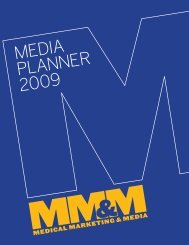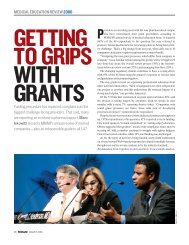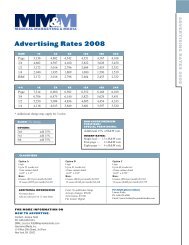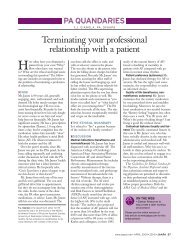Essential Guide to E-mail Marketing - Haymarket
Essential Guide to E-mail Marketing - Haymarket
Essential Guide to E-mail Marketing - Haymarket
Create successful ePaper yourself
Turn your PDF publications into a flip-book with our unique Google optimized e-Paper software.
40 E-MAIL CAMPAIGNS DM News • E-Mail <strong>Marketing</strong> <strong>Guide</strong> 2007<br />
When e-<strong>mail</strong> design goes bad<br />
BY JULIAN SCOTT<br />
Time and time again I discover that one of the main obstacles<br />
<strong>to</strong> creating effective, visually engaging, brand-propelling<br />
and, most important, results-driven e-<strong>mail</strong>s is the creative team behind<br />
them.<br />
There are many fac<strong>to</strong>rs that need <strong>to</strong> be considered when designing<br />
an e-<strong>mail</strong>: how much content there will be, whether there will<br />
be dynamic content, how the design will organize the content,<br />
what call <strong>to</strong> action <strong>to</strong> use and how it will be coded. Everything<br />
needs <strong>to</strong> come <strong>to</strong>gether in unison<br />
<strong>to</strong> deliver an e-<strong>mail</strong> message that<br />
will deliver the most results.<br />
Several critical points your creative<br />
team must keep in mind:<br />
Best practices are best practices<br />
for a reason Unless it will work<br />
in 99.9 percent of environments,<br />
it is not a best practice and<br />
should generally be avoided.<br />
Print is not the same as e-<strong>mail</strong><br />
How the recipient will interact<br />
Julian Scott<br />
with and read it will be very dif-<br />
Responsys<br />
ferent. E-<strong>mail</strong>s are rarely viewed<br />
in their entirety. You have <strong>to</strong> be able <strong>to</strong> tell your s<strong>to</strong>ry within consolidated<br />
chunks that are clear, easily scanned and actionable.<br />
E-<strong>mail</strong>s are read <strong>to</strong>p <strong>to</strong> bot<strong>to</strong>m and left <strong>to</strong> right, so placing the<br />
headline at the bot<strong>to</strong>m of the e-<strong>mail</strong> is not going <strong>to</strong> work. You<br />
have only a few seconds <strong>to</strong> grab their attention — don’t waste it<br />
making them search for the primary points or call <strong>to</strong> action.<br />
The way you would code a Web page is not the same way you<br />
code an e-<strong>mail</strong>, and you must adjust your design <strong>to</strong> accommodate<br />
no background images, no Flash, no forms, no java script, no<br />
CSS, no image maps.<br />
An e-<strong>mail</strong> is never the destination. It serves as a stepping s<strong>to</strong>ne <strong>to</strong><br />
motivate recipients <strong>to</strong> take an action. If the e-<strong>mail</strong> is not designed<br />
with this in mind, then you’ve missed the point and wasted your<br />
money.<br />
Remember, if recipients cannot read your e-<strong>mail</strong> because the primary<br />
content is below the fold or coded in a way that will not render<br />
correctly, they are not likely <strong>to</strong> take an action.<br />
Some simple things you can do include making sure your creative<br />
team attends industry events and stays on <strong>to</strong>p of industry<br />
trends and news. Also, try <strong>to</strong> include them as part of your marketing<br />
planning process. Often, just understanding “why” is critical <strong>to</strong><br />
effective implementation. Always be sure <strong>to</strong> share results and<br />
encourage creative thinking that can be validated through testing.<br />
Julian Scott is creative direc<strong>to</strong>r at Responsys. You can reach him at<br />
jscott@responsys.com.<br />
ESSENTIAL GUIDE<br />
Keys <strong>to</strong> trigger-based e-<strong>mail</strong><br />
marketing<br />
BY MICHAEL THOMPSON<br />
Imagine having the power <strong>to</strong> send your cus<strong>to</strong>mers a message at the<br />
precise moment they are most likely <strong>to</strong> act on it. Imagine never<br />
again having <strong>to</strong> play the guessing game of throwing an offer out<br />
there and hoping it will stick. Instead, imagine having information<br />
regarding your cus<strong>to</strong>mers’ life-changing events, such as the purchase<br />
of a home or opening of a checking account, at your fingertips, and<br />
the dexterity <strong>to</strong> send out the right<br />
offer at precisely the right time.<br />
Well, there’s no need <strong>to</strong> imagine.<br />
Trigger-based marketing programs<br />
are enabling e-<strong>mail</strong><br />
marketers <strong>to</strong> communicate<br />
insightful offers in a timely fashion<br />
<strong>to</strong> both cus<strong>to</strong>mers and<br />
prospects, yielding as much as a<br />
400 percent improvement in<br />
response rates without costing<br />
millions of dollars.<br />
Michael Thompson<br />
Triggers 101 Triggers generally<br />
eServices at Click Tactics<br />
fall in<strong>to</strong> four categories: external<br />
(something happening in the mortgage or housing industry, for<br />
example); cus<strong>to</strong>mer life (marriage, retirement); behavioral (cus<strong>to</strong>mer<br />
purchase or dropped service) and communication (inquiry<br />
about a product upgrade or service). Each represents a specific<br />
moment when the cus<strong>to</strong>mer is both interested and engaged.<br />
Today’s most successful campaigns use triggers <strong>to</strong> au<strong>to</strong>matically<br />
initiate e-<strong>mail</strong> when cus<strong>to</strong>mers take certain actions. This is done<br />
by establishing a set of business rules that act on pre-assigned criteria.<br />
Trigger-based e-<strong>mail</strong> programs enable marketers <strong>to</strong> turn existing<br />
cus<strong>to</strong>mer data in<strong>to</strong> business rules that systematically drive a<br />
program through execution at greatly reduced campaign cycle<br />
times.<br />
Two key fac<strong>to</strong>rs: timing and relevancy Timing and relevancy are<br />
the foundation on which successful marketing programs are built.<br />
Missing on either front can often spell disaster for a campaign.<br />
Much as a dancer needs both rhythm and knowledge of the right<br />
steps <strong>to</strong> dance, marketers must hit both “right message” and “right<br />
time” <strong>to</strong> move the cus<strong>to</strong>mer <strong>to</strong> action. By aligning the content and<br />
timing of e-<strong>mail</strong> messages with cus<strong>to</strong>mer needs, you’re increasing<br />
the relevance, response and, ultimately, revenue from your direct<br />
marketing programs.<br />
Assisted by new robust e-<strong>mail</strong> platforms and on-demand technologies<br />
that enable triggered communications using dynamic content,<br />
companies can deliver individualized, relevant<br />
communication <strong>to</strong> each cus<strong>to</strong>mer. What’s more, e-<strong>mail</strong>s can be<br />
used as part of a multi-<strong>to</strong>uch communications strategy allowing<br />
marketers <strong>to</strong> deliver messages over a variety of channels based on<br />
cus<strong>to</strong>mer preference and at varying intervals, enabling marketers<br />
<strong>to</strong> send out thousands or just a few at the appropriate time. These<br />
programs tell the cus<strong>to</strong>mer, “Hey, we know you and here’s how<br />
we can help you specifically.”<br />
Keep it simple When implementing trigger-based programs,<br />
keep it simple. Don’t reconfigure your current systems or dramatically<br />
change internal processes. Your trigger-based solution should
















